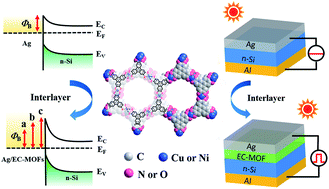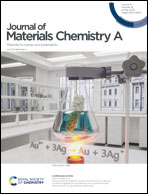A highly oriented conductive MOF thin film-based Schottky diode for self-powered light and gas detection†
Abstract
The application of Schottky junction in self-powered devices is limited by low efficiency in both separation and transport of photogenerated electrons/holes. This issue may be overcome by introducing electronically conductive metal–organic framework (EC-MOF) materials into the junction and limited by preparing high-quality thin films of EC-MOFs. In this study, for the first time, high-quality EC-MOF thin films were demonstrated as effective interlayer materials to solve the above-mentioned issue by modulating the height of Schottky barrier (ΦB). The EC-MOF-based self-powered Schottky diode can act as a photodetector and demonstrate the highest external quantum efficiency (84%) for all reported self-powered photodetectors as well as the broadest detectable spectrum range (250 to 1500 nm), high on–off ratio (∼103) and short rise (0.007 s) and fall time (0.03 s). Furthermore, it can be used as a gas sensor for typical harmful gases and vapors.



 Please wait while we load your content...
Please wait while we load your content...